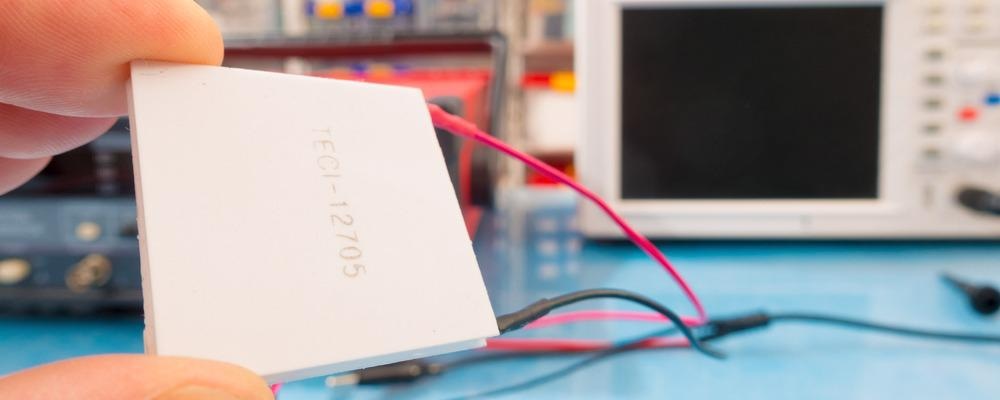Technological advances in fields such as wearable electronics and the Internet of Things (IoT) are central to the 4th Industrial Revolution. Flexible energy harvesting is essential for these technologies and devices must be reliable and display superior electrical and mechanical properties. A paper published in Applied Thermal Engineering has demonstrated a flexible thermoelectric generator that has a new structured design, which could improve energy harvesting for a multitude of devices.

Study: Flexible Bi2Te3-based thermoelectric generator with an ultra-high power density. Image Credit: luchschenF/Shutterstock.com
The Demand for Power Generation
Recently, there has been an exponential expansion in the market for wireless sensors and micro-power generation systems. The power demand of these devices facilitates the need for self-generating energy devices. Conventional battery technologies cannot meet these demands as they must be recharged or replaced and are not thin enough.
Flexible, wearable smart devices and materials offer significant advantages for this market, due to their low cost and ability to withstand mechanical deformation. However, current flexible technologies have some drawbacks, including complex manufacturing processes, low strength, and reliability issues.
Thermoelectric generators have been investigated recently for self-powered energy harvesting devices that can be used in wearable devices and IoT devices. These devices convert low-grade thermal energy into electrical energy, providing power. These devices are advantageous because they achieve clean, reliable, noiseless, and vibrationless energy conversion.
Inorganic materials such as carbon allotropes, copper chalcogenides, and Bi2Te3 are commonly used in thermoelectric generators. Of these materials, Bi2Te3 shows the greatest potential for room temperature applications due to its high thermoelectric merit, mature barrier technology, and stability. This material is extensively used in current thermoelectric generators.
Improving the Design and Performance of Bi2Te3 Generators
In current thermoelectric generators, a layer of Bi2Te3 is sandwiched between two sheets of copper bonded ceramic substrates. However, these devices are brittle and do not work well as flexible technologies as deformation causes their thermal resistance to increase. This leads to a sharp decrease in power generation capabilities.
For this reason, research into alternative materials has been undertaken recently to design reliable and efficient flexible thermoelectric generators. Two main strategies have been devised to overcome the issues and realize the potential of these devices.
One strategy is to use flexible thermoelectric films such as semiconductors with high plasticity, conjugated organic polymers, and thin-layered Bi2Te3 materials. However, these devices suffer from low power density in the nanowatt range as well as reliability and aging issues during long-term service.
Printing Next-Generation Flexible Electronics
The other strategy uses a structural design of rigid, inorganic thermoelectric legs with an organic substrate. Many current studies have demonstrated the feasibility of this strategy. Interestingly, some researchers have reported flexible thermoelectric generator designs that display healing and recycling features. Whilst this strategy shows great promise, challenges still exist with complicated assembly processes, low strength, shear stress during mechanical deformation, and high thermal resistance.
Creating a Novel Flexible Thermoelectric Generator
To overcome these issues, the team behind the research published in Applied Thermal Engineering developed a novel flexible thermoelectric generator. The fabrication of the device avoided complex steps. Additionally, it was more reliable and achieved an ultra-high-power density. Power density levels were amongst the best reported for flexible thermoelectric generators.
The design included 18 pairs of miniaturized thermoelectric legs sandwiched between two flexible substrates, the top substrate is cut into blocks which allowed for improved flexibility when being worn or deformed. Performance remained almost the same after the generator was subjected to 7400 bending cycles.
Additionally, the open-circuit voltage and temperature difference displayed a good linear relationship, meaning that the generator has great potential for self-powered temperature sensor applications. The research paper has demonstrated a novel device that has a rational and practical design, laying the groundwork for the application of thermoelectric generators in wearable electronics and IoT devices.
The Future
Flexible, wearable technology such as sensors, IoT devices, telecommunication devices, and biomedical applications are growing in popularity with applications in multiple industries being developed. If the field is to reach its true potential, devices must be able to rely on self-powering capabilities, which current battery technologies, as well as flexible technologies, fall short on.
The work presented in the study in Applied Thermal Engineering has demonstrated the design of a thermoelectric generator with superior reliability, mechanical and electrical properties, and a simplified fabrication process. Innovation like this will inform the future of the wearable electronics and IoT sectors and lay a solid foundation for next-generation flexible thermoelectric generator technology. This will provide enhanced power capabilities for a slew of devices central to the 4th Industrial Revolution.
Further Reading
You, H et al. (2021) Flexible Bi2Te3-based thermoelectric generator with an ultra-high power density [online] Applied Thermal Engineering 117818 | sciencedirect.com. Available at: https://www.sciencedirect.com/science/article/abs/pii/S1359431121012424
Disclaimer: The views expressed here are those of the author expressed in their private capacity and do not necessarily represent the views of AZoM.com Limited T/A AZoNetwork the owner and operator of this website. This disclaimer forms part of the Terms and conditions of use of this website.